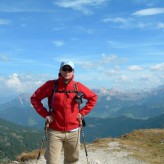This week´s Centerfault is the famous Arkitsa Fault in Greece (38.43°N, 23.00°E). Along this about 500 m long and locally more than 40 m high excavated limestone fault plane within Mesozoic platform carbonates are uplifted against Pliocene-Quaternary sediments.
 The fault belongs to a ESE-WNW striking segmented north-dipping fault system starting in the northern Gulf of Evia belonging to the Almyros-Sperchios graben structure. Walker et al. (2010) estimated Holocene slip rates of 0.7 – 2 mm/yr based on the uplift calculations of 0.2 mm/yr by Goldsworthy and Jackson (2001).
The fault belongs to a ESE-WNW striking segmented north-dipping fault system starting in the northern Gulf of Evia belonging to the Almyros-Sperchios graben structure. Walker et al. (2010) estimated Holocene slip rates of 0.7 – 2 mm/yr based on the uplift calculations of 0.2 mm/yr by Goldsworthy and Jackson (2001).
The probably most fascinating feature of the fault plane cutting through the cemented fault breccia is the large polished scarp surface, showing slip parallel striations, as well as cracks and fissures perpendicular to the slip direction. Jackson and McKenzie (1999) described the fault plane in detail and determined for the excavated segment of the fault the slip direction 345/52. Using terrestrial laser scanning by Jones et al. (2009) showed comparable slip directions (336–344°/51–57°) over the whole outcrop even so the fault plane is undulating and is changing dip and strike.
In contrast, to the artificially exhumed polished fault plane, the subaerial or natural outcrop has a little degraded or no fault scarp. On the other hand in the hanging wall a mega-colluvial wedge formed with nicely inclined strata.
Unfortunately, the fault plane is situated in a rubbish dump site, which leaves a particular aroma.





No Comments
No comments yet.